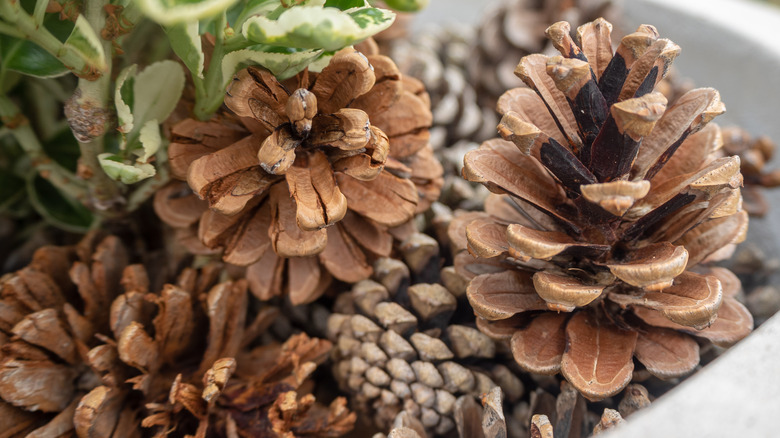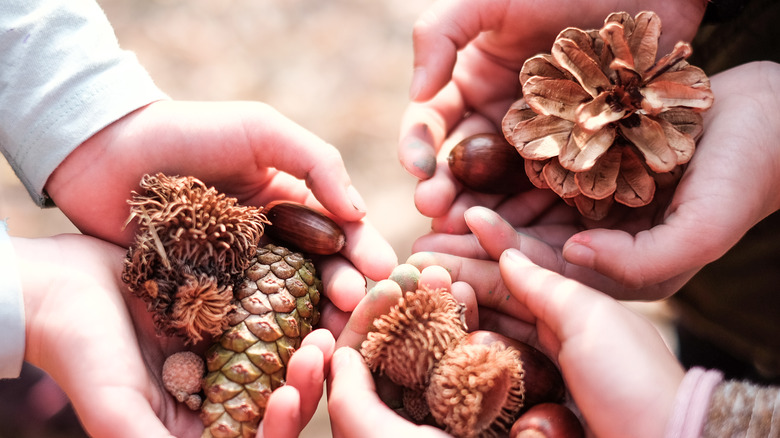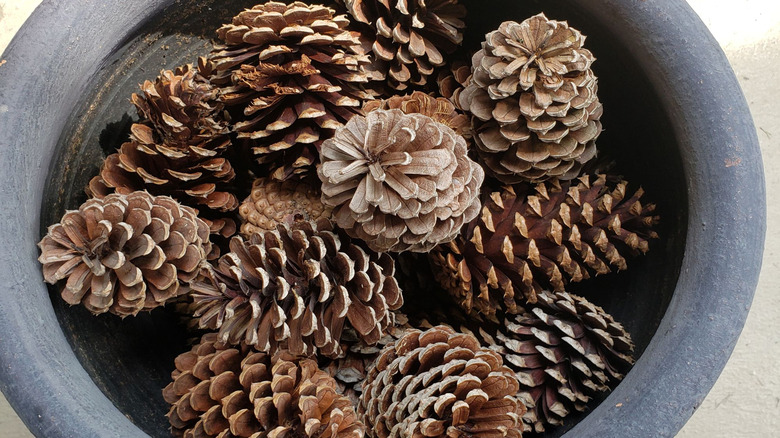Why You Should Start Adding Pinecones To The Bottom Of Your Planters
Garden planters come in all shapes, sizes, and materials, and large planters can be used for shrubs and even small trees. Although sometimes the entire space of a large planter may be needed for a plant's root system, usually only the top few inches are taken up by plants. To lessen the overall weight of the planter, filling the bottom half with lightweight material, not soil, is recommended. One of the best lightweight natural materials to use to take up space in the bottom of your planters is pinecones.
Materials like pinecones relieve your plants of excess moisture in addition to lowering the overall weight of the planter compared to filling the entire planter with soil. Unlike synthetic materials, like plastic water bottles, bubble wrap, or styrofoam, pinecones are all-natural and won't add any undesirable chemicals to your planter's contents. Using pinecones to fill in the bottom half of your planter also means purchasing less soil. Since pinecones are free to pick up in your yard or the woods — unless you live in a non-wooded area, of course — they're also a thrifty choice.
Because of their shape and low density, pinecones add air pockets to help keep root systems healthy. They also improve drainage in the container to prevent root rot. Pinecones also break down slowly into soil over time. They not only add compostable nutrients to your soil, but they also lend a slight acidity to the soil while they are composting, which is desirable for many plants.
What kinds of pinecones should you use?
Any pinecones or other cones produced by conifers (like fir or spruce trees) can be used for this purpose. But the best ones to use are larger pinecones or pinecones that have a lot of space between their bracts (the pointy or curved parts that extend out from the central stem). Some pinecones have bracts that are very close together and dense, which means they don't create the air pockets that those with farther apart bracts do.
It's also good to use pinecones that have already dropped to the ground, rather than picking them. Once they've dropped off or been plucked off the tree, they begin to dry out. This makes them lighter, and they will already have begun the slow process of decomposition, which helps them break down into soil. Some trees that produce pinecones also drop large pine needles, and these can also be placed in the bottom of planters to help improve drainage. Be sure to check any materials you might put in your plant pots — you don't want to accidentally introduce any fungal diseases to your houseplants.
Putting pinecones in planters
If you're using pinecones for your plant pots, put pinecones at the very bottom of your planters, leaving enough room for the plant's root system and the accompanying soil. If you have a filter that helps prevent water from leaking out of the bottom of your planter, or a dish, this is a good way to avoid any possible issues with water draining out too quickly. When you layer the pinecones, have them fill up about a third of your container, unless your plant has a very large root system and needs more space.
Then, put your potting soil in and fill in any space left by the pinecones; there will still be plenty of good air pockets for drainage as the pinecones slowly break down. As the pinecones break down over time, this may affect the level and volume of the soil. You can put more potting soil into the planter when the level goes down. The pinecones will add good texture to the soil to keep it well-draining, and the air pockets help the roots receive nourishment from the soil. You can also use pinecones for smaller planters to help improve drainage and soil texture. Just use smaller pinecones, and line the bottom of the container with them before you add your potting soil.
If you have extra pinecones at your disposal, you could consider throwing them into a woodchipper to yield pinecone mulch. You could also put some smaller pinecones in the top of your plant pots as a way of keeping your pets from digging up your houseplants.


